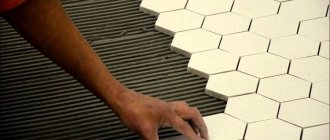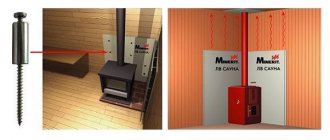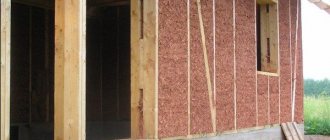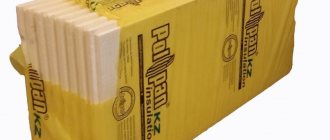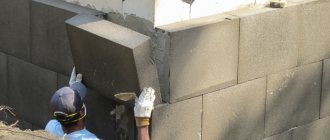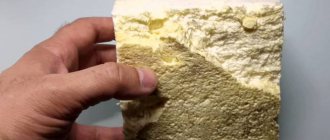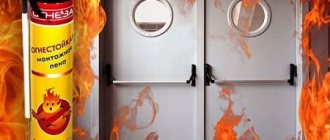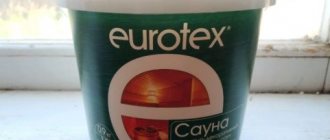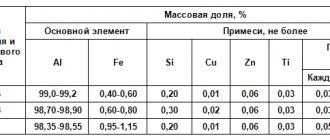Perlite
Perlite
is a rock of volcanic origin.
The outermost strip of lava (with a temperature of +500...+1200°C), in contact with the ground, quickly cools (hardens), resulting in obsidian. Later, under the influence of groundwater, a new rock is formed from it - perlite
. It is characterized by a special structure in the form of rounded particles reminiscent of pearls (hence the name: perle - “pearl” in French). Perlite can range in color from white to black and come in various shades of green or brown. It contains constitutional water in the form of molecules attached to the surface of individual sections of the crystalline structure of the mineral.
Since perlite is saturated with water, when crushed rock is heated by shock in furnaces, it swells, forming spherical particles with an increase in volume of up to 20 times and a porosity of 70-90%. This is how expanded perlite is produced - grains of different fractions of white or light gray color, hard, but crumbly. Bulk material with a particle size from 1 to 5 mm is called agroperlite
and are used in gardening and horticulture.
Properties and Features
Considering the origin of perlite, it can be understood that it has no nutritional value for our green pets. Even the potassium, magnesium, sodium, iron and other elements included in its composition are in a bound state and cannot be absorbed by plants. That is, it is not a fertilizer
. However, it is widely used, taking into account its special properties:
- chemical inertness,
- neutral acidity (pH = 7),
- biological stability (does not decompose),
- flowability and lightness,
- ability to absorb water up to 400% of its own weight.
The soil is mixed with perlite to improve the structure. It becomes loose, breathable, does not cake and does not sour. The low thermal conductivity of perlite protects the root system of plants from overheating and hypothermia. Absorbing water in large volumes, the granules of this material then gradually release it, so the humidity remains stable for a long time. The roots of plants develop the earthen ball more actively and evenly.
Basic properties of agroperlite
Adding perlite to the soil has several effects:
- Maintains air-water balance. Soil mixed with perlite remains crumbly for a long time, does not cake or compact. A surface crust that interferes with air exchange does not form.
- Actively absorbs moisture and prevents soil acidification. After watering, it increases in volume almost 4 times. Then the granules gradually release water as the soil dries, thus ensuring uniform moistening of the soil.
- Increases light reflection. Perlite on the surface acts as a barrier to prevent overheating of the plant root system.
- Provides optimal heat conduction, makes the soil loose, which protects against sudden temperature changes, that is, protects the roots from excessive heating and cooling.
- Enhances the effectiveness of used agricultural fertilizers. Through loose soil, organic matter and nutrients more easily reach the roots of flowers and vegetables.
Adding agroperlite to the soil makes the work of the gardener and gardener easier. This is due to the fact that the need for watering is reduced, the risk of root rot is reduced, and the yield increases by about 50%. It remains in the soil for up to 3-4 years, then naturally disintegrates.
Agroperlite, in addition to water, is capable of attracting part of the fertilizers and gradually releasing them in the future if they are introduced in excess. That is, in agoroperitic soils the likelihood of oversaturation of plants with fertilizers is minimal.
pros
You should also familiarize yourself with the advantages of this breed. Chief among them are:
- This is a biologically pure component that eliminates diseases and pests that overwinter in the soil.
- It is indispensable when the soil in the garden is dense and plants with a weak root system do not grow on it.
- The ability to accumulate moisture and feed the plant for a long time.
- There is no caking, so even after a long time there will be no decrease in the water and air permeability of the soil.
- Perlite provides high-quality thermal insulation.
This breed is used not only in growing plants, but also for preserving crops. If it is treated with fungicides, it will be possible to prevent fruits and vegetables from freezing, and also protect them from rotting. But to achieve this result, it is necessary to lay a layer of perlite of at least 5 cm between the layers of fruit.
Application in floriculture
Flower growers use perlite for plants quite often. Most flowers are quite picky about soil, especially its structure. And perlite is an excellent drainage material and a substance that increases soil aeration. Thanks to these properties, the soil with its addition is well ventilated, saturated with oxygen, the moisture level is regulated and its excess is absorbed by the substance. The moisture is evenly distributed and, at the right time, reaches the root system of the plants.
In such substrates, roots are less susceptible to rotting, drying out, and consequently the development of root diseases.
The health of the root system directly affects the condition of the entire plant and its flowering.
Perlite is used in several ways:
- As drainage. I place the substance at the bottom of the pots, and pour the soil mixture on top.
- For rooting plants. Some plants take root very poorly in the soil, since the bacteria content in it causes rotting. In this case, perlite can serve as a substrate.
- In the soil mixture. This method is suitable for plants with weak root systems. The mixture is prepared in this way: perlite, peat and soil are mixed in the same ratio.
- Instead of peat, you can use humus. As a component in soil mixtures, this substance can enhance the performance of the planting mixture. The perlite content can reach up to 40%.
- To increase the air humidity in the room, wet material is laid out on pallets and placed in the room.
- When sowing small seeds, in order to evenly distribute them on the planting site, add fine perlite and mix.
- Mulching the top layer prevents the formation of a crust after watering, which means it does not block the access of oxygen to the soil.
- Fertilizer base.
Flaws
It would seem that the material is environmentally friendly and very convenient for use in gardening, but it has an extremely unpleasant property - it generates dust. Moreover, this dust is very dangerous if it gets into the lungs and eyes. These microneedles remain in the soft tissue of the lungs and bronchi and are not removed. Therefore, when working with agroperlite, you must first spray it with water - and be sure to use a respirator and goggles, especially when throwing bulk material on the beds. For the same reason (due to the spread of hazardous dust by wind), this treated volcanic rock should not be used for mulching large areas outdoors.
Agroperlite is dusty. Agroperlite particles have slight abrasive properties, but this may be enough to cause damage to the thin roots of plants during replanting. Pure perlite can be alkalized by hard water, potassium or sodium fertilizers. Therefore, such a substrate cannot be used for growing plants that require acidic soil for good development. So, we can say that agroperlite is a very attractive component of the soil mixture for indoor plants and seedlings. It solves several annoying soil problems well and really becomes a reliable gardener's assistant. However, it must be remembered that this soil additive does not provide nutritional value for plants and is not considered a fertilizer. Also, if for some reason you don’t have agroperlite, then it is quite possible to replace it with coarse river sand or other loosening materials.
Features of the use of perlite
When packaging and transporting perlite, a certain amount of dust is generated. This glass dust can cause you a lot of inconvenience. Therefore, we need to get rid of it. Simply moisten it with a spray bottle. But if you want to completely wash the dust out of the perlite, then wrap it in a piece of gauze and place it under running water.
Although perlite contains various microelements needed by plants, they are all in a bound state and do not reach the plants. Therefore, the use of perlite does not exclude fertilizing the plants.
Although perlite is neutral, if you use hard water to water your plants, it will shift from its neutral state to the alkaline side. This is not good for some plants. When using rain, snow or softened water, alkalization of perlite does not occur.
Where is it used?
The properties and characteristics of perlite have made it necessary in many industries, agriculture, and environmentalists.
Metallurgy
This is a valuable material for metallurgists:
- The mineral is added to many grades of steel and cast iron. In fact, a mixture of cementite and ferrite turns into pearlite.
- The shape of pearlite is determined by cementite. Depending on the type of its crystals, pearlite agglomerates can be lamellar or granular.
- Austenite (a high-temperature modification of iron) becomes pearlite during the slow cooling of steel or cast iron. In this case, the modification of iron changes, and excess carbon is released as cementite or carbide.
The pearlite structure facilitates further machining of steel.
Metallurgists use perlite as an insulator and protection against fire or heat. The mineral can withstand a temperature range from -200 to +900°C.
Other industries
The benefits of mineral raw materials are recognized by specialists in other industries:
- For the oil and gas complex, the ability of a mineral to absorb oil or fuel oil film from the surface of reservoirs is important. Cement with the addition of perlite is used to strengthen the walls of oil and gas wells.
- Pharmacists use it to purify liquid medications.
- Manufacturers of vegetable oils, beer, wines, syrups, and juices cannot do without the mineral as a purifier.
In each case, a specific type of raw material is used.
Cleaning
For ecologists and adherents of a healthy lifestyle, the properties of perlite as an adsorbent are of particular importance:
- The mineral is used to purify water in plumbing, swimming pools, aquariums, and sewage.
- They rid the soil of chemicals, radiation, and other contaminants. Which is especially important for industrialized regions.
Perlite is a popular filler for home and industrial water filters.
Landscape design
The rock of volcanic origin does not rot or decompose by microorganisms. Rodents or insects do not live in it.
That’s why lawns and sports fields are covered with pebbles. Water does not accumulate on them. Grass grown on soil with a mineral supplement does not dry out even in drought.
It is much easier to care for such a lawn, especially a large field.
Other areas
The mineral impregnated with flavorings is used instead of tobacco in hookahs.
This is an environmentally friendly way to humidify the air in the heat or during the heating season. To do this, raw materials of large fractions are generously moistened and laid out on a pallet or other surface. The water will evaporate gradually.
Collectors of mineral collections are interested in pristine rocks from different parts of the planet and processed versions.
Expanded perlite
Expanded perlite is a natural, environmentally friendly material obtained as a result of heat treatment of volcanic aluminosilicate rock. Due to its porous structure, perlite is a highly effective heat and sound insulating material with a thermal insulation coefficient λ of 0.04 W/m°C. Expanded perlite has excellent sorption properties, is fire-resistant, bio-resistant and chemically inert. The use of perlite is possible in the temperature range from -200°C to +875°C.
Benefits of perlite
- Safety. Perlite is absolutely safe for humans, does not cause allergic reactions or skin irritation, and does not harm the indoor climate.
- Fluidity. This quality allows perlite to completely fill all voids and cavities of wall masonry. Thus, the problem of continuous insulation, which is inherent in rigid insulation, is solved.
- Inorganic. Perlite by its nature is volcanic glass, so it is not subject to rotting, and parasites and ants do not grow in it.
- Non-flammability. Due to the fact that the melting point of perlite is 1100-1200°C, it is non-flammable, and when heated it does not emit harmful components, products made from expanded perlite increase the fire resistance of structures several times.
- Soundproofing. Such qualities of perlite as porosity and fluidity also allow it to be used as an effective soundproofing material. Due to their uneven shape, perlite granules adhere closely to each other, which reduces the transmission of sound waves through walls and ceilings.
- Economical. Thermal insulation based on expanded perlite provides excellent thermal and fire-resistant properties of walls at low cost. It is lightweight and quickly fills the necessary voids in the masonry without the use of special equipment and skills.
- Durability. Perlite insulation does not lose its properties over time and does not settle in heat-protective shells, in the voids of wall masonry and in the wall blocks themselves.
To clarify delivery conditions and prices for perlite, call! Sales from 10 m3 (retail possible).
Depending on the soil types, mixtures are used in the following proportions:
| Small M 75 | Small M 100 | Large M 75 | Large M 100 | Agro-perlite | Sorbent PetroSorb | Filter-perlite | Backfill thermal insulation Thermo-FG | |
| Size of the main fraction, mm | 0,16-1,25 | 0,16-1,25 | 1,25-5 | 1,25-5 | 1,25-5 | 0,16-5 | 0,16-5 | 1,25-5 |
| Volume - bulk mass, kg/m³ | up to 75 | 75-100 | up to 75 | 75-100 | 75-100 | 100 | 120-160 | 75-100 |
| Mass fraction of moisture, % no more | 1 | 1 | 1 | 1 | 1 | 2 | 1 | 1 |
| Thermal conductivity coefficient, W/m°C | 0,04 | 0,043 | 0,048 | 0,05 | 0,053 | — | — | 0,05 |
| Mass fraction of particles floating in water, % no more | — | — | — | — | — | — | 1,2 | — |
Perlite is packaged in paper, plastic or Big Bag bags (1-1.5 m³) with shipment in covered wagons, by road (sending by our own special transport is possible, in a volume of 80 m³ in bulk).
Application of perlite
- Construction - used both independently as thermal insulation fills and as fine aggregate for building materials and mixtures, for example, plasters, masonry mortars, lightweight concrete, paints, insulating panels, etc.
- Agriculture - adding perlite to the soil can improve its structure, for example, increase the aeration properties of heavy clay soils, increase the moisture capacity of light sandy soils. Due to its neutral pH, perlite helps reduce soil acidity and slow down the process of soil salinization. Agricultural perlite (agroperlite) is also used for germinating seeds and rooting cuttings.
- Metallurgy - for insulating the melt surface in ladles, molds and casting molds.
- Medical, food, oil refining industries - filter perlite powder of various grades for filtration of vegetable and technical oils, sugar syrups, fruit juices, beer, pharmaceuticals, etc.
- Ecology - as a sorbent for eliminating pollution during emergency spills of petroleum products.
- Cryogenic installations - as thermal insulation at critically low temperatures (-200°C and below).
- Oil and gas industries - lightening perlite additive to oil well cements for cementing oil and gas wells.
To the Perlite page
- Consultation
- Order a calculation
- Want to buy
- Consultation
- Order a calculation
- Want to buy
Need a consultation?
Will answer questions about price, selection of options and delivery of products
| Name | Vadim Kublanov |
| Telephone | 8 (ext. 189) |
The use of perlite in bulk construction
The best option is to use perlite in bulk, since cold bridges may remain in the bags when laying them. As fill-in insulation in construction, it is used in floors and walls - it is poured between joists and into voids formed either by well masonry or a sealed frame. Due to its volatility, the material generates a lot of dust, so it is better to work with a respirator. But the accusations that it provokes asthma almost from the first day, sometimes appearing on our forum, are more of a “horror story” than a real danger.
Thermal insulation boards made of perlite
Thermal insulation boards, which contain perlite sand and various binders (bitumen, lime, polymer compounds, cement, gypsum, clay, liquid glass), are manufactured by hydraulic pressing.
For normal positive and low negative temperatures, including areas of deep cold, perlite-bitumen products, such as slabs, are used.
The composition of perlite-bitumen slabs, which are used for thermal insulation of building structures and roofs of industrial buildings, includes perlite sand, bitumen, clay, asbestos, glue, sulfite-yeast mash (SYB) and water. Such perlite blocks can withstand temperature changes from -60 to +100 degrees Celsius and are divided into low-flammable (bitumen content is 9%) and low-flammable (bitumen content is 10÷15%).
The main advantages of insulating perlite slabs: low weight, high sound and heat insulation characteristics; resistance to rotting; resistance to deformation and mechanical stress.
Perlite in building mixtures
Perlite (grades M75 or M100) is used as a component in dry mixtures (cement- and gypsum-perlite), significantly improving their properties. Application of ready-made dry perlite mixtures: for plastering work; for leveling surfaces, that is, arranging self-leveling floors.
The solution is prepared very simply: water is added to the finished dry mixture in the proportion indicated on the package. Compared to conventional plaster, perlite plaster has more effective thermal insulation (a layer of such plaster 3 cm thick in its thermal insulation properties can be equated to 15 cm thick brickwork), sound insulation, fire resistance (about 5-10 times higher), high vapor permeability, frost resistance and resistance to rotting. It is suitable for both internal and external work.
Expanded perlite is a material that improves the quality of the masonry mixture
Content:
1. Perlite, what is it?
2. Use of perlite to improve the properties of the masonry mixture
3. Advantages and disadvantages of perlite
The material in this article will be of particular interest to those people who are planning to build their own home. Indeed, by adding expanded perlite to the mixture for laying bricks, it is possible to significantly improve the performance characteristics of brick walls. But let's talk about everything in order.
Perlite, what is it?
Perlite is one of the natural minerals formed as a result of the interaction of volcanic glass (obsidian) with groundwater. This leads to the transformation of volcanic glass into a new substance - obsidian hydroxide or perlite.
There are several types of perlite rock structure, for example:
• obsidian , in which obsidian impurities are present;
• spherlitic , which contains feldspar impurities;
• resin stone , which has virtually no impurities, and others
This natural material is used in various fields of human activity, for example, in medicine, in the production of cigarettes, in the glass, chemical and metallurgical industries, and so on. However, we are most interested in how perlite is used in construction .
The use of perlite to improve the properties of masonry mixtures
Most often in the construction industry, it is not the perlite rock that is used, but a specially prepared material - expanded perlite . In appearance, it consists of granules of different sizes with an irregular round shape. And because of the characteristic shine of such granules, they are often compared to pearls. Although, in terms of its strength, pearls are much stronger than porous perlite.
Expanded perlite is intended for adding to cement-sand mortar for bricklaying. In many countries around the world, its production is on a large scale , since the demand for this material is growing every day. This is not surprising, because with the advent of such a mixture filler for bricklaying, builders have the opportunity not only to improve the quality characteristics of the mortar itself, but also to give it more visual appeal.
Just recently, perlite was considered an ultra-modern building material in our country, but now it won’t surprise anyone, since nowadays buy perlite in any specialized store. In addition, expanded perlite is one of the components of a ready-made mixture for bricklaying, labeled M200 , which includes both traditional fillers ( quartz sand and cement ) and a completely new component - expanded perlite. It is this additive that gives the usual ready-made mixture for bricklaying such an important property as reduced thermal conductivity . Thus, perlite introduced into the composition of such a mixture eliminates the occurrence of cold bridges in the brickwork ( directly in the seams ) , which makes it possible to reduce the loss of thermal energy through the walls of buildings and structures.
It is the structure of perlite that provides not only its good thermal insulation properties, but also excellent interaction with traditional substances from which the masonry mixture is made, which provide the reinforcing properties of this building material ( meaning sand and cement ) . However, the use of the ready-made mixture, which contains perlite, is not limited to narrowly targeted use as a mortar for laying bricks. It is perfect for performing work on leveling the surface of the main concrete floor ( for example, by making a screed ) or making the main floor itself ( concreting it ) . In addition, the mixture can be used for plastering
walls, both inside and outside buildings. As noted earlier, the introduction of a substance such as expanded perlite into the mixture makes it possible to reduce the leakage of thermal energy through the walls of building structures in the construction of which the M200 by up to 10% . If you fill all the voids in the walls with expanded perlite, then your house will receive almost perfect thermal insulation of the walls! Thus, perlite made the ready-made mixture M200 bricks universal, allowing it to carry out any construction work.
Advantages and disadvantages of perlite
Well, let's draw conclusions about the advisability of using expanded perlite in the construction of stone houses. Manufacturers of expanded perlite guarantee a significant improvement in the properties of the masonry mixture, among which the most important are:
• excellent adhesion to the main surface; • absence of even the most minimal shrinkage; • consistency of technical characteristics regardless of temperature changes; • increased resistance to mechanical stress in the form of compression ( about 196 kgf/cm²) ;
• reduction in the level of thermal conductivity of walls to 10%;
• attractive appearance of the mortar in the joints between rows of bricks. However, this wonderful building material has only one, but quite significant, drawback - its high cost. This means that its presence in the masonry mixture makes it significantly more expensive compared to a conventional cement-sand mixture for laying bricks. Although I would like to note that these additional costs will more than pay off due to savings in payments for consumed heat in the winter! Thus, the advantages of this material significantly exceed its disadvantages!
Tags: Perlite
- < Back
- Next >
Add a comment
JComments
Categories
Construction materials and technologies
DIY repair
Country house, dacha
Plumbing and electrical
Landscape design
It is important to know!
Home interior
Other articles about repairs
Pros and cons of frame-panel houses
Qty
How to build a cottage with your own hands
Qty
The advantage of suspended ceilings
Qty
How to prepare an apartment for a major renovation
Qty
Finishing the loggia with decorative stone
Qty
How to deal with cracks in timber
Qty
How to clean a drain
Qty
What to build a house from?
Qty
Most read
- DIY artificial stone painting
- Aligning wall corners with your own hands
- Do-it-yourself leveling of walls with putty
- Expanded perlite is a material that improves the quality of the masonry mixture
- DIY wooden plinth installation
Popular tags
appliance space wall plywood doors Cork floor in the kitchen home roof floor pump interior Garden paths in the country house finishing construction Types of siding for the house design loggia Wiring wire
How to insulate a house using perlite
Perlite is used as insulation in the form of sand (bulk insulation); component in thermal insulation products and dry ready-made building mixtures.
Perlite sand as insulation for walls
Perlite sand for arranging thermal insulation of a house is an excellent material with which you can not only effectively insulate a home (heat loss is reduced by 50%), but also significantly lighten the structure of the building.
We begin installing thermal insulation from foamed perlite after part of the load-bearing wall (internal) and external brickwork (4-5 rows) have already been erected. We pour coarse expanded perlite sand (with a granule size of about 6 mm), previously dust-free, into the gap between these two walls and compact it thoroughly (the volume should decrease by 10%).
We fill the sand manually or using a sandblasting machine. We repeat this operation several times until the walls are completely erected. By the way, in terms of heat-saving properties, a perlite layer about 3 cm thick corresponds to a 25 cm thick brick wall. When building panel houses, we pour sand between the sheathing sheets (internal and external).
If you are insulating an old house with voids in the walls, then backfilling with sand can be done in two ways:
- carefully pull out several bricks from the wall and pour perlite through the resulting hole;
- drill a hole in the wall (diameter 30÷40 mm) and through it, using a special installation, inject heat-insulating material.
Perlite sand is a universal non-combustible building material that has a number of advantages:
- excellent sound, noise and heat insulation properties (and can be used to insulate walls made of any material);
- environmental friendliness;
- lightness (by weight);
- resistance to temperature changes;
- durability.
Advice! You should not use perlite sand, which is a very moisture-intensive material, as insulation in places with high humidity.
The only disadvantage of sand is that it is very dusty: therefore, it is recommended to slightly moisten it before use.
Floor insulation with perlite
For thermal insulation of floors, we use expanded perlite, which is poured onto the cement-sand base of the floor and leveled according to building regulations. The height of the thermal insulation layer of sand is the desired thickness plus 20% additional volume for shrinkage.
Important! The recommended minimum thickness of the perlite layer is at least 1 cm.
We embed uneven areas and pipelines in a layer of bulk material, and lay slabs and flooring on top. If there is no basement under the house, then in order for moisture to accumulate and be removed, we place drainage pipes and absorbent pads under the perlite.
Another effective way to insulate a concrete floor can be to lay a kind of “pie”: we install a perlite screed between two layers of concrete. First, prepare a perlite solution with the following components:
- cement – 1 mᶟ;
- perlite – 3 mᶟ (grade M75 or M100);
- sand – 2.2 mᶟ;
- water – 1.5 mᶟ;
- plasticizers – 3÷3.5 l.
Stir all the components of the mixture until water comes to the surface: this is a sure sign that the solution (perlite screed) is ready for use.
Advice! Since perlite is a very light material, it is recommended to carry out all work with this material indoors so that the wind does not in any way interfere with the work process.
After the perlite screed is applied to the concrete base, we leave it to harden. After 1 week we get an excellent thermal insulation layer for the floor that will last for many years. We lay a second layer of concrete on top of it.
Roof insulation
If you do not intend to equip a living space in the attic, then it will be quite enough to insulate only the attic floor with expanded perlite. Otherwise, we pour perlite between the beams of the roof slope into boxes that are specially made for this purpose; then compact the sand thoroughly. The work does not require specific skills or knowledge.
Also, for thermal insulation of sloping roofs, perlite is used, which is treated with bitumen in the factory. We add a solvent to this bituminized perlite and get an adhesive solution, with which you can create a durable thermal insulation layer.
Soil preparation
In order for the seedlings to develop normally, it is necessary to prepare not only fertile, but also soft soil for them. In heavy soil, gas exchange processes are disrupted, and the development of the root and the entire plant as a whole is inhibited.
Site preparation usually begins in the fall. It is cleaned of old grass and fruits, antiseptics, organic and mineral fertilizers are added.
- For 20 kg of soil mixture, use 3-5 liters of vermiculite. The same goes for 1 m2.
- The substrate is evenly distributed over the surface of the bed and dug up.
- It is recommended to update the material after 5-7 years. Over time, it crumbles into small round grains.
We recommend: How to use perlite for flowers?
The mineral is also used by home gardeners to grow indoor plants. Why is perlite added to the soil? It keeps it moist and soft. It is introduced for growing violets, pelargonium, and begonia, which are very sensitive to microclimate. The mineral is added to the soil mixture for citrus plants. It can be used as a separate material if hydroponic technology is used.
Many home plant growers are interested in how much perlite to add per 1 liter of soil. Flowers are grown in pots. Their size is measured in liters. When using a substrate, the rule always applies - no more than 30% of the total amount of soil mixture. For 1 liter you will need about 30 g of mineral.
The material is light, it can be difficult to determine its weight by eye. You can use a tablespoon. Flower growers add 2-3 tbsp per 1 liter of soil mixture. l. mineral filling. Additionally, mineral is placed for drainage and mulching.
Before using perlite, it must be rinsed or moistened. The material emits dust, which causes coughing, runny nose, and watery eyes.
How to use perlite
Perlite in its pure, unprocessed form is usually used in construction, but expanded perlite is much more interesting for gardeners. It is used for a variety of purposes, since the material is completely safe.
True, this substance also has several disadvantages. Firstly, perlite is not cheap, so it will be expensive to use it in the desired volumes. Secondly, not all garden stores offer it. Thirdly, on the white surface of perlite it is more difficult to notice mealybugs, fungus gnats and other soil pests. Finally, although the pH of perlite crystals is neutral, exposure to hard tap water causes the pH to shift to the alkaline side, which slows down plant growth.
Hydroponics
Grains of the substance are also used as hydroponics, replacing soil with them. It is also used as drainage, poured onto the bottom of the pot and leveled. A florist can use it to increase air humidity.
To do this, large fractions of perlite are poured onto a tray, moistened and flower pots are placed on it. This is convenient during drought and heating season, when plants need to be watered frequently. The moisture will evaporate gradually and remain in the air longer than after using a spray bottle.
Perlite is convenient for storing planting material and flower bulbs. The additive is poured in layers: the layer of the substance is the tubers of the plant. Finish with another layer of perlite. In such conditions, planting material is stored longer, rots less, and does not germinate ahead of time. It reduces the likelihood of developing mold and fungal infections.
The moistened fraction is recommended to be used for preparation before planting and planting in open ground. The use of the additive improves the structure of the soil and makes it lighter. Perlite reduces the acidity of the soil, making it more alkaline. The soil does not become waterlogged even with a lot of rain. When using perlite, the roots do not freeze in the spring after planting young plants. Flowers and crops freeze less often in winter (if additional covering material is used).
Perlite for seedlings and seeds
In perlite (or its mixture with soil) you can germinate seeds, root cuttings and grow seedlings without fear of mold, blackleg and putrefactive diseases. This substance takes in water and then gradually releases it, giving the sprouts only the required amount of moisture. However, if you decide to use pure agroperlite without additives, keep in mind that it is sterile, and you will need to constantly add a nutrient solution to the containers, otherwise the sprouts will simply wither.
It is better to prepare a soil mixture containing 25% agroperlite, 25% lowland peat, 25% humus and 25% turf soil.
Ordinary perlite is excellent as mulch for seedlings - it prevents the top layer of soil in containers from drying out and overheating in the sun.
Perlite for flowers
For indoor flowers, as well as crops grown in pots, perlite is also very important. It is used as drainage, mulch and, most importantly, a loosening agent and soil normalizer. A soil mixture containing at least a quarter of perlite does not become acidic, does not become salty, and does not allow mosses and lichens to grow. In addition, it does not dry out as quickly as usual, which means it solves the problem of irregular watering.
Perlite for storing bulbs, tubers, seedlings
If you have particularly valuable bulbs or seedlings that you want to preserve until spring, you can also use perlite. The bulbs and tubers are placed in a box on a layer of this material, sprinkled so that they do not touch each other and do not come to the surface. In this case, they will not germinate prematurely, will not become moldy, will not dry out, and will not suffer from temperature changes.
You can store vegetables, fruits or root vegetables in the same way, but it will be very expensive.
In addition, adding expanded perlite to the hole when planting trees and bushes in the fall will provide good wintering for young seedlings. In 3-4 years, the perlite granules will disintegrate on their own, and until then they will serve as reliable protection for thin absorbent roots.
Perlite against poor root growth
To prevent a dense crust from forming in a container with a flower or in a garden bed after watering or in the heat, perlite is also used. Compaction of the top layer of soil threatens to dry out the substrate and impair root growth.
Therefore, ordinary loosening can briefly replace watering. After the gardener has loosened the soil, oxygen enters the soil better and the roots breathe.
In order not to loosen the beds every time after rain, they are mulched with humus or bought perlite. Granules of the substance are used less often, because they have a high cost. It is expensive to use them for large beds and greenhouses.
Gardeners recommend purchasing a package that is enough to mulch several indoor plants. Analogue substitutes are often used. It is not recommended to sprinkle granules near the plant trunk. This area remains unused. Watering is carried out through it.
On many private plots the soil is clayey and dense. The situation is different only in gardens with a sandy substrate. But even sand does not guarantee that plants will bloom comfortably on such soil. Such soil cakes and does not allow air to pass through well. One option would be to add perlite to the soil in a ratio of eight to one.
Additionally, the soil is fertilized so that the plants grow and develop faster. If the crop bears fruit, then the added perlite granules improve the yield and accelerate ripening. You can pour granules directly into the holes, after removing excess soil from the holes. Inside the hole, the soil is mixed with perlite, and then the plant is planted.
For indoor flowers, the additive consumption is much less. For this reason, it is often used for ornamental plants and flowers. It is necessary to mix the granules with the soil and pour them into a growing container. Perlite is taken no more than 30% of the total volume of the mixture.
The substance is also used for storing fruits, planting material and vegetables. Instead, sawdust and sand are used. The layer of perlite granules should not be more than five centimeters. Storage is carried out in boxes.
Perlite and vermiculite
Vermiculite is similar in properties to perlite and is also often used for growing garden and indoor plants. It is used as a drainage layer or mulching. But it contains more useful substances, such as potassium and calcium, which plants need for full growth.
Perlite is a neutral material. At the same time, its granules do not alkalize or acidify the soil. There is no need to select fertilizers for them. With vermiculite, it is necessary to select dosages and compositions of mixtures in order to avoid an overdose of active substances and not harm the plants. Many gardeners consider its color more pleasant than that of perlite.
Rules for using perlite for plants: how to use perlite correctly
Even if you understand what perlite is, you can use it in gardening and indoor floriculture in different ways:
- Like drainage. In this case, a 3-5 cm layer of pure agroperlite is simply poured onto the bottom of the pot.
- For rooting. Many gardeners are interested in the question of how to use perlite to root plants that show poor growth in regular soil. In this case, it is necessary to use clean perlite, after watering it abundantly with water. Due to the absence of any microorganisms in perlite, the possibility of rotting of the roots of young seedlings will be eliminated.
- As an additive to the soil mixture. A similar soil mixture with perlite is recommended for use for flowers and plants that have a weak root system. To prepare it, perlite, chernozem and peat (can be replaced with humus) are mixed in equal parts.
- To increase air humidity, which tropical plants need. In this case, additional trays with wet perlite must be placed near the flower pots.
- For sowing very small seeds. By mixing the seeds with fine agroperlite, it is possible to achieve their uniform distribution over the plot or box.
- As mulch. Covering the surface of a flower pot with perlite will prevent the top layer of soil from drying out and allow air to regularly flow to the root system of the flower.
- As a basis for fertilizers. To do this, just water the perlite with mineral fertilizer diluted in water and sprinkle it on the soil around the plants. Over time, perlite will begin to release moisture along with fertilizer into the soil.
What to replace perlite with?
Vermiculite, brick chips, fine expanded clay, polystyrene foam and sand are used as a leavening agent instead of perlite.
Vermiculite dries out more slowly between waterings. At the same time, it is less prone to caking, does not create voids when backfilling, and does not have an abrasive effect on the roots.
Brick and expanded clay have an alkaline reaction, so they are not recommended for plants that require acidic soil. Expanded clay also actively reacts to the temperature of the external environment - the substrate with it heats up faster in the heat and cools down in the cold.
Crushed polystyrene foam and sand (not river, but a larger fraction) will also prevent caking, but they do not have the ability to store moisture and fertilizers and gradually release them to the roots.
Sources
- https://zen.yandex.ru/media/id/5ddcd0f78798bb77f7268f8a/chto-takoe-perlit-i-kak-ego-pravilno-ispolzovat-v-sadovodstve-5e207cc2e3062c00b03cd3ea
- https://sadovnikam.ru/415824a-chto-eto-takoe-perlit-i-dlya-chego-on-nujen
- https://7dach.ru/Eleko/chto-takoe-perlit-i-kak-ego-pravilno-ispolzovat-v-sadovodstve-243790.html
- https://dcactus.ru/perlit/
- https://jgems.ru/podelochnye/perlit
- https://www.forumhouse.ru/journal/articles/7146-perlit-kak-uteplitel-harakteristiki-opyt-uchastnikov-portala
- https://zamesbetona.ru/podgotovka/perlit-chto-jeto-takoe.html
- https://www.ogorod.ru/ru/now/soil/14705/est-vopros-chto-takoe-perlit-i-kak-ego-pravilno-ispolzovat.htm
- https://chudoogorod.ru/prochee-sad/perlit-kak-ispolzovat-dlya-rastenij.html
- https://flosium.ru/post/detail/chto-takoe-perlit-i-dlya-chego-on-nuzhen/
